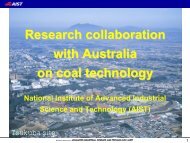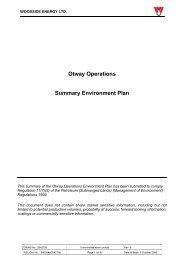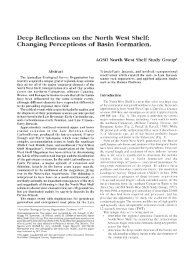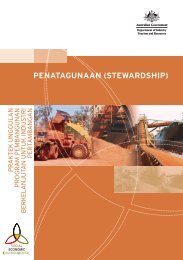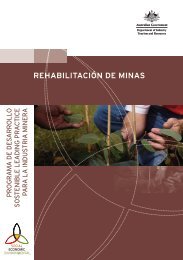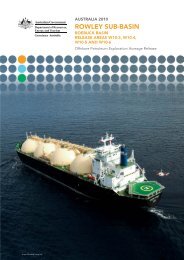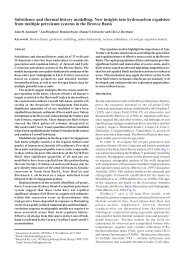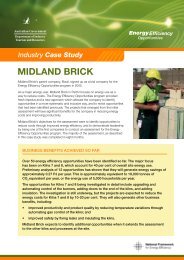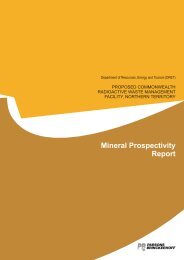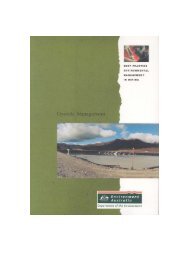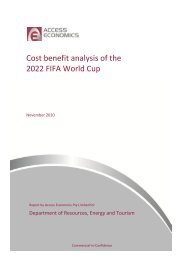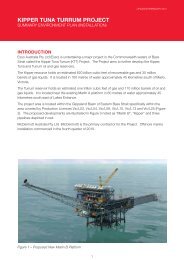A guide to leading practice sustainable development in mining
A guide to leading practice sustainable development in mining
A guide to leading practice sustainable development in mining
Create successful ePaper yourself
Turn your PDF publications into a flip-book with our unique Google optimized e-Paper software.
Lead<strong>in</strong>g <strong>practice</strong> management of water quality should also <strong>in</strong>clude management and<br />
moni<strong>to</strong>r<strong>in</strong>g of process reagents, solid and liquid wastes (<strong>in</strong>clud<strong>in</strong>g domestic wastes),<br />
hydrocarbons, degreasers and sewage effluents. These aspects can be particularly<br />
important dur<strong>in</strong>g periods of high ra<strong>in</strong>fall, when it may be difficult <strong>to</strong> reta<strong>in</strong> all surface<br />
and groundwater runoff from m<strong>in</strong><strong>in</strong>g-related <strong>in</strong>frastructure, <strong>in</strong>clud<strong>in</strong>g contrac<strong>to</strong>r sites.<br />
The water quality <strong>guide</strong>l<strong>in</strong>es do not fully address the difficulties associated with<br />
their application <strong>to</strong> temporary waters. In particular, the trigger values conta<strong>in</strong>ed <strong>in</strong><br />
the <strong>guide</strong>l<strong>in</strong>es are based on steady-state conditions that by def<strong>in</strong>ition do not occur<br />
<strong>in</strong> temporary waters; there are no <strong>to</strong>xicity-based trigger values provided for <strong>in</strong>land<br />
salt lakes; and the recommended biological water quality assessment strategies are<br />
untested for m<strong>in</strong><strong>in</strong>g impacts <strong>in</strong> all but a few types of temporary waters. This limits<br />
their use <strong>in</strong> the arid and semi-arid zones of Australia, where temporary waters<br />
dom<strong>in</strong>ate, and where the majority of m<strong>in</strong><strong>in</strong>g occurs.<br />
Habitat structure <strong>in</strong> aquatic ecosystems is a major controll<strong>in</strong>g fac<strong>to</strong>r of biodiversity.<br />
Sedimentation of stream beds, pools and backwaters can result <strong>in</strong> reduced<br />
biodiversity due <strong>to</strong> the reduction <strong>in</strong> the available niches. Stream diversions that do<br />
not match the pre-exist<strong>in</strong>g habitat structural diversity will be unlikely <strong>to</strong> support the<br />
orig<strong>in</strong>al aquatic biodiversity. This may affect biodiversity upstream and downstream<br />
of the diversion by alteration of organism passage and reach-scale ecosystem energy<br />
flow. Lead<strong>in</strong>g <strong>practice</strong> managers design compensa<strong>to</strong>ry habitat structures <strong>in</strong><strong>to</strong> the<br />
diversion, such as plant<strong>in</strong>g additional overhang<strong>in</strong>g reeds, rushes and shrubs and<br />
construct<strong>in</strong>g natural or above natural densities of large woody debris structures.<br />
The eng<strong>in</strong>eer<strong>in</strong>g design of the diversion should account for the <strong>in</strong>creased hydraulic<br />
roughness associated with these structures.<br />
Alteration of the landscape caused by m<strong>in</strong><strong>in</strong>g that results <strong>in</strong> altered flow paths and<br />
velocities of surface and ground waters will result <strong>in</strong> altered geomorphic <strong>in</strong>fluence on<br />
the receiv<strong>in</strong>g aquatic ecosystems. The resultant impacts on aquatic habitat structure<br />
and the biodiversity dependent upon it need <strong>to</strong> be considered.<br />
The Community and M<strong>in</strong><strong>in</strong>g Operations<br />
The Bus<strong>in</strong>ess Case for Community Engagement<br />
Engag<strong>in</strong>g with communities and contribut<strong>in</strong>g <strong>to</strong>wards community <strong>development</strong> is not<br />
only the right th<strong>in</strong>g for companies <strong>to</strong> do, it also makes sound bus<strong>in</strong>ess sense. First<br />
and foremost, companies need <strong>to</strong> secure broad community support and acceptance<br />
<strong>in</strong> order <strong>to</strong> protect their ‘social licence <strong>to</strong> operate’.<br />
Companies that are perceived as closed and non-responsive will be much less likely<br />
<strong>to</strong> have the trust and support of a community than those which share <strong>in</strong>formation<br />
openly, listen and respond <strong>to</strong> people’s concerns, and show that they care about<br />
the community and are committed <strong>to</strong> its <strong>development</strong>. By listen<strong>in</strong>g and engag<strong>in</strong>g,<br />
companies will also be better placed <strong>to</strong> identify emerg<strong>in</strong>g community issues at an<br />
early stage and deal with them proactively rather than reactively. Consequently,<br />
these companies will also have a greater opportunity <strong>to</strong> put their views <strong>to</strong> the<br />
community, and hav<strong>in</strong>g those views heard.<br />
The time taken <strong>to</strong> plan, f<strong>in</strong>ance, <strong>in</strong>sure and regulate any operation has <strong>in</strong>creased<br />
substantially <strong>in</strong> the past few decades, particularly <strong>in</strong> the case of large-scale m<strong>in</strong>es.<br />
In these circumstances, there can be real f<strong>in</strong>ancial returns for those companies that<br />
94 LEADING PRACTICE SUSTAINABLE DEVELOPMENT PROGRAM FOR THE MINING INDUSTRY



